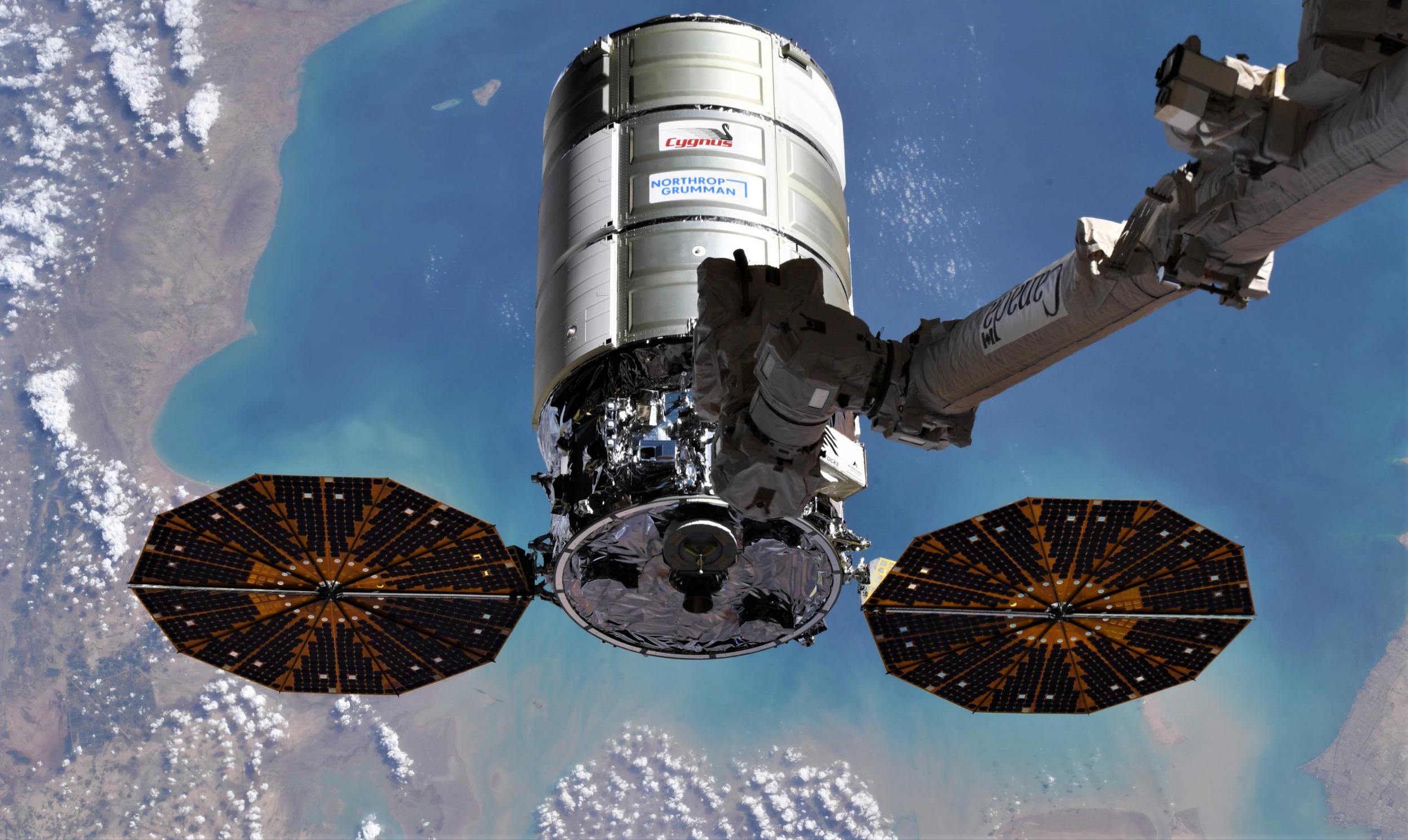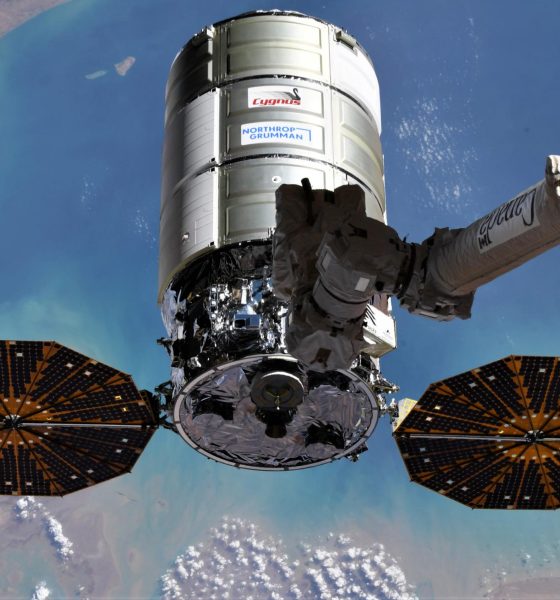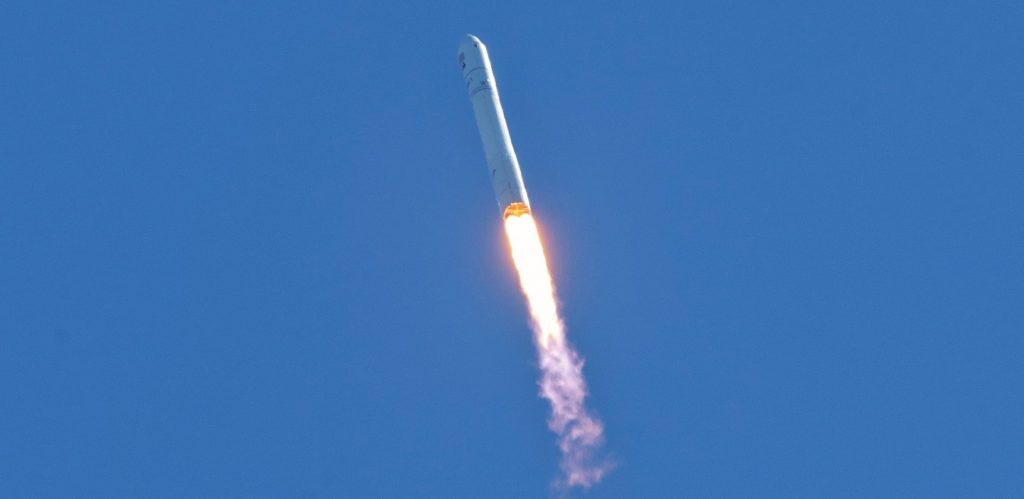

News
Antares rocket launches Cygnus spacecraft to the International Space Station
Northrup Grumman has launched a fresh batch of supplies and equipment to the International Space Station with its Antares rocket and Cygnus spacecraft.
On Saturday, February 19th, an uncrewed Northrup Grumman Cygnus spacecraft lifted off on an Antares rocket from Pad 0A at NASA’s Wallops Flight Facility in northeast Virginia. As part of Northrup Grumman’s 17th Cargo Resupply Services (CRS) mission to the International Space Station since 2013, the rocket successfully carried the Cygnus spacecraft and more than 3.7 tons (~8300 lb) of cargo into orbit.
At 4:44 AM EST Monday, February 21st, Cygnus finished its autonomous rendezvous with the ISS and the station’s robotic Canadarm2 arm – operated by NASA astronaut Raja Chari – grabbed the hovering spacecraft and ultimately installed it on a berthing port later that morning. Prior to its arrival, NASA astronauts Raja Chari and Kayla Barron trained on the US Destiny laboratory module’s robotics workstation to prepare for the capture operation.

The update that's rolling out to the fleet makes full use of the front and rear steering travel to minimize turning circle. In this case a reduction of 1.6 feet just over the air— Wes (@wmorrill3) April 16, 2024
On February 22nd, ISS astronauts began the process of unpacking Cygnus, which brought with it an array of supplies, snacks, scientific investigations, and critical materials needed to support over 250 experiments aboard the ISS. That list of experiments includes medical research, technology development, space safety work, and plant life investigations. In one investigation, cancer cells from breast and prostate cancer will be treated with MicroQuin, a novel cancer treatment drug. This investigation will allow tumors to be treated in a microgravity environment, allowing researchers an opportunity to better understand and characterize their structure, gene expression, cell signaling, and response to the treatment.
The NG-17 mission also carried a modification kit that will pave the way for the installation of the new set of upgraded solar arrays. The second batch will be launched no earlier than (NET) May 2022 on SpaceX’s CRS-25 Cargo Dragon 2 spacecraft. Additionally, NASA says that Cygnus NG-17 “[included] other components [needed] for the successful functioning of astronaut life on the space station, such as a trash deployer and acoustic covers for the waste management system.” (NASA)
In general, NG-17 was loaded with:
• 2,980 pounds (1,352 kilograms) of crew supplies
• 2,883 pounds (1,308 kilograms) of [station] hardware
• 1,975 pounds (896 kilograms) of science investigations
• 200 pounds (100 kilograms) of unpressurized cargo
• 132 pounds (60 kilograms) of spacewalk equipment
• 77 pounds (35 kilograms) of computer resources
While attached to the ISS, Cygnus will also be responsible for raising the altitude of the space station for the first time in its history. This will be the first time since the Space Shuttle’s retirement in 2011 that an American spacecraft helps maintain the space station’s orbit – a task Russia has exclusively handled for more than a decade. “This Cygnus vehicle has been modified to [use some of its own propellant] to reboot ISS. We’ve done a test prior to this with Cygnus, but this will be our first real use of this capability to actually re-boost the station. And it gives us another way to do so, in addition to the Russian Zvezda thrusters or the Russian Progress cargo spacecraft capabilities,” stated Dina Contella, NASA’s ISS operations integration manager.
Cygnus will remain attached to the International Space Station for the next three months and is set to depart in May. Once detached from the ISS, the spacecraft – operating a bit like a space tug or orbital transfer vehicle – will deploy a number of cubesats. Finally, the fully expendable spacecraft will dispose several thousand pounds of trash when it reenters and burns up in Earth’s atmosphere later this year.

News
Tesla hosts Rome Mayor for first Italian FSD Supervised road demo
The event marked the first time an Italian mayor tested the advanced driver-assistance system in person in Rome’s urban streets.

Tesla definitely seems to be actively engaging European officials on FSD’s capabilities, with the company hosting Rome Mayor Roberto Gualtieri and Mobility Assessor Eugenio Patanè for a hands-on road demonstration.
The event marked the first time an Italian mayor tested the advanced driver-assistance system in person in Rome’s urban streets. This comes amid Tesla’s push for FSD’s EU regulatory approvals in the coming year.
Rome officials experience FSD Supervised
Tesla conducted the demo using a Model 3 equipped with Full Self-Driving (Supervised), tackling typical Roman traffic including complex intersections, roundabouts, pedestrian crossings and mixed users like cars, bikes and scooters.
The system showcased AI-based assisted driving, prioritizing safety while maintaining flow. FSD also handled overtakes and lane decisions, though with constant driver supervision.
Investor Andrea Stroppa detailed the event on X, noting the system’s potential to reduce severe collision risks by up to seven times compared to traditional driving, based on Tesla’s data from billions of global fleet miles. The session highlighted FSD’s role as an assistance tool in its Supervised form, not a replacement, with the driver fully responsible at all times.
Path to European rollout
Tesla has logged over 1 million kilometers of testing across 17 European countries, including Italy, to refine FSD for local conditions. The fact that Rome officials personally tested FSD Supervised bodes well for the program’s approval, as it suggests that key individuals are closely watching Tesla’s efforts and innovations.
Assessor Patanè also highlighted the administration’s interest in technologies that boost road safety and urban travel quality, viewing them as aids for both private and public transport while respecting rules.
Replies on X urged involving Italy’s Transport Ministry to speed approvals, with one user noting, “Great idea to involve the mayor! It would be necessary to involve components of the Ministry of Transport and the government as soon as possible: it’s they who can accelerate the approval of FSD in Italy.”
News
Tesla FSD (Supervised) blows away French journalist after test ride
Cadot described FSD as “mind-blowing,” both for the safety of the vehicle’s driving and the “humanity” of its driving behaviors.

Tesla’s Full Self-Driving (Supervised) seems to be making waves in Europe, with French tech journalist Julien Cadot recently sharing a positive first-hand experience from a supervised test drive in France.
Cadot, who tested the system for Numerama after eight years of anticipation since early Autopilot trials, described FSD as “mind-blowing,” both for the safety of the vehicle’s driving and the “humanity” of its driving behaviors.
Julien Cadot’s FSD test in France
Cadot announced his upcoming test on X, writing in French: “I’m going to test Tesla’s FSD for Numerama in France. 8 years I’ve been waiting to relive the sensations of our very first contact with the unbridled Autopilot of the 2016s.” He followed up shortly after with an initial reaction, writing: “I don’t want to spoil too much because as media we were allowed to film everything and I have a huge video coming… But: it’s mind-blowing! Both for safety and for the ‘humanity’ of the choices.”
His later posts detailed FSD’s specific maneuvers that he found particularly compelling. These include the vehicle safely overtaking a delivery truck by inches, something Cadot said he personally would avoid to protect his rims, but FSD handled flawlessly. He also praised FSD’s cyclist overtakes, as the system always maintained the required 1.5-meter distance by encroaching on the opposite lane when clear. Ultimately, Cadot noted FSD’s decision-making prioritized safety and advancement, which is pretty remarkable.
FSD’s ‘human’ edge over Autopilot
When asked if FSD felt light-years ahead of standard Autopilot, Cadot replied: “It’s incomparable, it’s not the same language.” He elaborated on scenarios like bypassing a parked delivery truck across a solid white line, where FSD assessed safety and proceeded just as a human driver might, rather than halting indefinitely. This “humanity” impressed Cadot the most, as it allowed FSD to fluidly navigate real-world chaos like urban Paris traffic.
Tesla is currently hard at work pushing for the rollout of FSD to several European countries. Recent reports have revealed that Tesla has received approval to operate 19 FSD test vehicles on Spain’s roads, though this number could increase as the program develops. As per the Dirección General de Tráfico (DGT), Tesla would be able to operate its FSD fleet on any national route across Spain. Recent job openings also hint at Tesla starting FSD tests in Austria. Apart from this, the company is also holding FSD demonstrations in Germany, France, and Italy.
Elon Musk
Tesla Optimus shows off its newest capability as progress accelerates

Tesla Optimus showed off its newest capability as progress on the project continues to accelerate toward an ultimate goal of mass production in the coming years.
Tesla is still developing Optimus and preparing for the first stages of mass production, where units would be sold and shipped to customers. CEO Elon Musk has always marketed the humanoid robot as the biggest product in history, even outside of Tesla, but of all time.
He believes it will eliminate the need to manually perform monotonous tasks, like cleaning, mowing the lawn, and folding laundry.
However, lately, Musk has revealed even bigger plans for Optimus, including the ability to relieve humans of work entirely within the next 20 years.
JUST IN: Elon Musk says working will be ‘optional’ in less than 20 years because of AI and robotics. pic.twitter.com/l3S5kl5HBB
— Watcher.Guru (@WatcherGuru) November 30, 2025
Development at Tesla’s Artificial Intelligence and Robotics teams has progressed, and a new video was shown of the robot taking a light jog with what appeared to be some pretty natural form:
Just set a new PR in the lab pic.twitter.com/8kJ2om7uV7
— Tesla Optimus (@Tesla_Optimus) December 2, 2025
Optimus has also made several public appearances lately, including one at the Neural Information Processing Systems, or NeurIPS Conference. Some spectators shared videos of Optimus’s charging rig, as well as its movements and capabilities, most interestingly, the hand:
You have to hand it to Elon 🤟 pic.twitter.com/fZKDlmGAbe
— Ric Burton · NeurIPS 2025 (@_ricburton) December 2, 2025
The hand, forearm, and fingers have been one of the most evident challenges for Tesla in recent times, especially as it continues to work on its 3rd Generation iteration of Optimus.
Musk said during the Q3 Earnings Call:
“I don’t want to downplay the difficulty, but it’s an incredibly difficult thing, especially to create a hand that is as dexterous and capable as the human hand, which is incredible. The human hand is an incredible thing. The more you study the human hand, the more incredible you realize it is, and why you need four fingers and a thumb, why the fingers have certain degrees of freedom, why the various muscles are of different strengths, and fingers are of different lengths. It turns out that those are all there for a reason.”
The interesting part of the Optimus program so far is the fact that Tesla has made a lot of progress with other portions of the project, like movement, for example, which appears to have come a long way.
However, without a functional hand and fingers, Optimus could be rendered relatively useless, so it is evident that it has to figure this crucial part out first.








